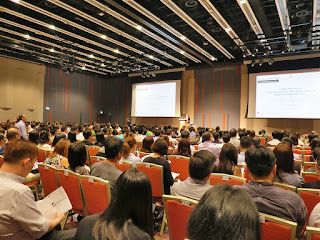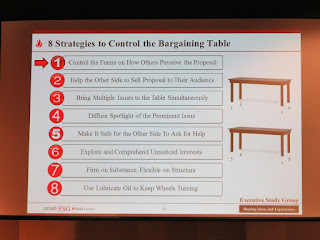The Executive
Study Group (ESG) seminar 2016 – Leadership Strategy series named “How to
Control the Bargaining Table to Build Your Influential Power” was held by
the ESG, Asia Pacific Institute for Strategy Limited (APIFS) and
the Hong Kong Science and Technology Parks Corp (HKSTPC) on 30 Aug 2016. I would like to summarize the seminar for
sharing below. (The seminar is full!)
Dr. Mark
Lee briefed the purpose of Executive Study Group (ESG) and he established 100
CEOs Peer Learning Group. He told us the
coming topics in the CEO Group included “Downturn Strategy”, “Design &
Innovation Strategy”, “Re-Branding and Marketing”, “Alliance and Plug-and-Play
Strategy” and “Organization Development Strategy”. He then also quoted Steve Jobs statement that
Creativity is just connecting things.
In the
beginning, Dr. Mark Lee discussed that negotiation was not debating. It was about Human Interaction that how might we engage with other human beings
in a way that leads to better understandings and agreements? The
definition of Negotiation is “the process by which two or more parties who perceives
a difference in interests or perspective attempt to reach agreement.” Then he used a case about NFL Strike in
2011. The revenue distribution between players
and owners did not compromise as follows:
Owner offering: Demanded a $2 billion off-the-top credit to
support investments before any split of revenues would take place. After which the players would receive
approximately 58% of what remained.
Players Offering: Player wanted no off-top credit
for owners and a 50-50 split of all revenues.
There
were two barriers making agreement difficult to reach and they were (A) The
Audience Problem and (B) Zero-sum Problem.
Finally,
one of clever man in owner’s team suggested three revenue buckets to solve the
deadlocked situation. Why? We discussed and got the following reasons.
First, it seems fairer. Second, it
changed the focus. And third, players
seem to get more through media.
Dr. Mark
Lee said the most important was Victory Claim in both parties!
Then Dr. Lee told us didn’t focus on stakes on the Table but the Bargaining Table itself. To move the Bargaining Table could get the different result.
After
that Dr. Mark Lee explained the 8 Strategies to Control the Bargaining Table.
1) Control the Frame on How Others Perceive the Proposal
The “Frame”
of the Negotiation is Psychological lens.
The frame should set for everyone to win. Dr. Lee raised an example about Diana’s
funeral. If only consider the
daughter-in-law of Queen Elizabeth II, it was not important because she had no
longer been Princess of Wales after divorce.
But if considered as the mother of the future king, the frame changed
and the whole funeral was different!
2) Help the Other Side to Sell Proposal to Their Audience
It is
because negotiators are too concerned about their own image. So we need to help other side to make a
justification for the decision maker.
Then Dr.
Mark Lee used a case about Royalty Rates on Licensing. They got stuck on royalty rate because IP owner expected the production would increase after Market Validation. But Licensee expected the royalty rates
should go down over time. Then IP owner proposed
quantity sold and time two dimensions calculation to solve the problem. If the quantity sold without increased, the
royalty rates went down with time.
However, quantity sold increased to certain amount, the new royalty
rates should be used. So that both sides were feel comfortable.
3) Bring Multiple Issues to the Table Simultaneously
Dr. Lee
said to avoid one-issue negotiation or issue one-by-one, because it was hard to
feel winning. Therefore, we needed to
negotiate multiple issues simultaneously, so as to create more options for
tradeoff. Moreover, it could help to
find out what each side really care about.
4) Diffuse Spotlight of the Prominent Issue
Similar
to strategy 3, negotiation party didn’t make one issue standing out (One issue).
It was only to attract supporters for aggressive opening position through a
single prominent issue situation. We
needed to avoid Win/Lose Outcome that splitting one issue into two or
more.
5) Make It Safe for the Other Side to Ask for Help
Trust could
reduce risk. How to build the trust? Don’t
take advantage when others are weak; and reciprocating on shared sensitive
information. Moreover, a healthy degree
of professional respect between the negotiators could help them signal to each
other.
6) Explore and Comprehend Unnoticed Interests
Hidden
interests could be reconcilable if we understand why they want it. If both
parties met their underlying interests, please stop arguing about “What they
want” (Positions) but start discussing their motivation for “Why they want it”
(Interests). Therefore, we could control
the bargaining table by moving to Interests from Position.
7) Firm on Substance, Flexible on Structure
Be Firm
as what you deserve (Interests) but not stubborn (Position). I know where I need to get; I’m flexible on
how we get there.
8) Use Lubricate Oil to Keep Wheels Turning
If no
immediate effect during negotiation, find offers to keep the ball rolling
through additional dimension. Then find other side’s audience needs and
crafting proposals like Lubricant Oil to maneuver around troublesome
issues. It aimed to reduce time on deadlock
so as to make it more likely to find out a mutually acceptable agreement.
Peer Learning
Last
part was peer learning through 5 minutes sharing. At the end, Dr. Lee gave us a
quick template using 8 strategies for audient team use before negotiation.
Reference:
Asia Pacific Institute for Strategy Limited (亞太策略研究所有限公司) – www.apifs.org
















沒有留言:
發佈留言